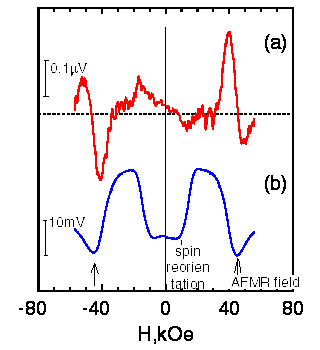
Figure:
Antiferromagnetic Stark-effect in the
Gd2CuO4. (f=36GHz,
T=1.4K)
(a)(red)-responce to an electric field:
component of the transmitted microwave signal
detected on the frequency of the AC electric
field vs. magnetic field
(b)(blue)-transmitted microwave power vs. magnetic
field
The antiferromagnetic Stark effect was found in an antiferromagnet
Gd2CuO4. It is the shift of the antiferromagnetic resonance
frequency under electric field. Stark- effect in an antiferromagnet is a linear
in electric field strength effect due to the linear magnetoelectric effect which
is known for antiferromagnets of certain symmetry types. The figure demonstrates
the influence of the electric field on the magnetic resonance in the experiment
with an AC-electric field which modulates the eigenfrequency of the
antiferromagnetic resonance and results in the field dependence of the
absorption in form of a derivative of the resonance line.
